The truth behind Francis Bacon’s ‘screaming’ popes
Father figure, drag queen or distillation of Nazi iconography? New Phaidon Focus book reveals the theories behind Francis Bacon’s obsessive reworking of the papal theme in his most famous Velasquez-inspired paintings
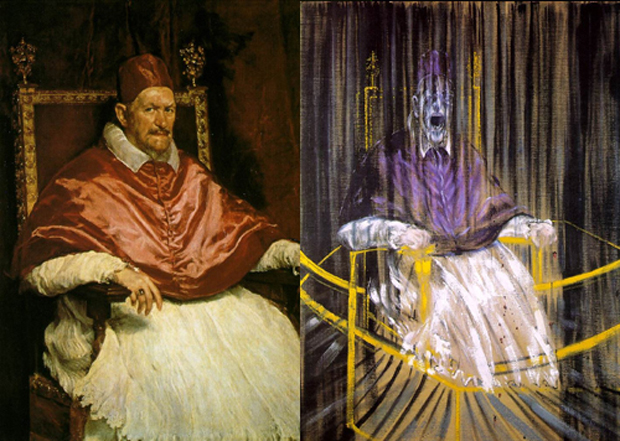
Diego Velazquez Pope Innocent X 1650. Study after Velazquez’s Portrait of Pop Innocent X 1953 © The Estate of Francis Bacon. All rights reserved.
Around this time last week we brought you a look inside Anselm Kiefer’s studio as part of a sneak preview from a Phaidon Focus book we’re publishing on the acclaimed German artist. Today our Phaidon Focus is on a series of Francis Bacon’s most famous paintings inspired by Velasquez’s Pope Innocent X portrait. Scholars have pored over the paintings and the possible inspirations behind them ever since Bacon painted them in the 1950s.
Bacon worked on his pope paintings, variations on Velázquez’s magnificent portrait of Pope Innocent X, for over twenty years. He was already exploring the idea while in the South of France in late 1946. The first surviving version (Head VI) dates from late 1949, and he finally stopped in the mid-1960s. Subsequently, Bacon announced that he thought the works ‘silly’ and wished he had never done them. He acquired endless reproductions of the Velázquez painting from books, but famously did not see the original when he visited Rome in late 1954.
Clearly Bacon was not just producing homages to a picture he loved. Artists have always made copies as creative exercises, and Bacon may have been particularly inspired by the example of Vincent van Gogh (1853–1890), who made many transformations of pictures that he especially admired by Eugène Delacroix (1798–1863), Jean- François Millet (1814–1875) and others. Bacon’s popes depart even further from their source, often replacing the pontiff’s head with the equally recognisable screaming face of the wounded nurse mown down by the soldiers’ gunfire in the Odessa steps sequence of Eisenstein’s film Battleship Potemkin.
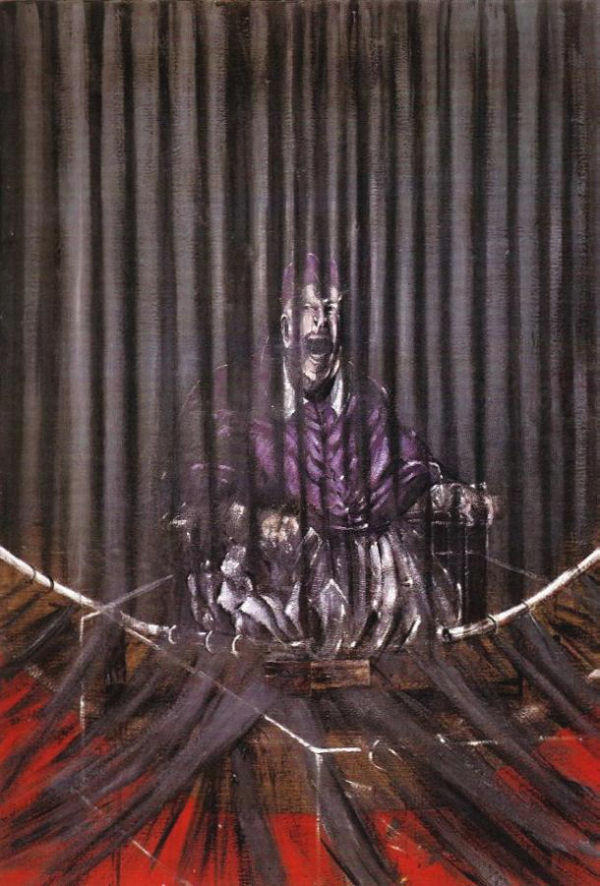
Study after Velazquez 1950 © The Estate of Francis Bacon. All rights reserved
The insertion subverts the encapsulation of power and self-assurance projected by Velázquez. The screaming mouth, isolated from other facial features and divorced from any narrative context, suggests existential agony. The pathos of human vulnerability and loss of faith or conviction are accentuated by the precisely rendered space frames in many Bacon images of popes, which make the figures register as ‘enclosed in the wretched glass capsule of the human individual’, to cite the evocative phrase used by the philosopher Friedrich Nietzsche in The Birth of Tragedy (1872), one of Bacon’s favourite books.
The papal theme may have had a more contemporary resonance for Bacon, given that he embarked on his variations in 1946 immediately after the completion of Painting, with its dense references to Nazi iconography. He may have been attracted to the Velázquez picture as an iconic distillation of power, which made it such a vivid precursor to Fascist propaganda photography. In later works in the series, Bacon inserted references to photographs of the then pontiff, Pope Pius XII, a controversial figure who was thought by some to have appeased the Nazis. A photograph of Pius on his throne, being carried from St Peter’s, appears in one of Sam Hunter’s 1950 studio montages, and was clearly the basis for some of the subsequent pope pictures.
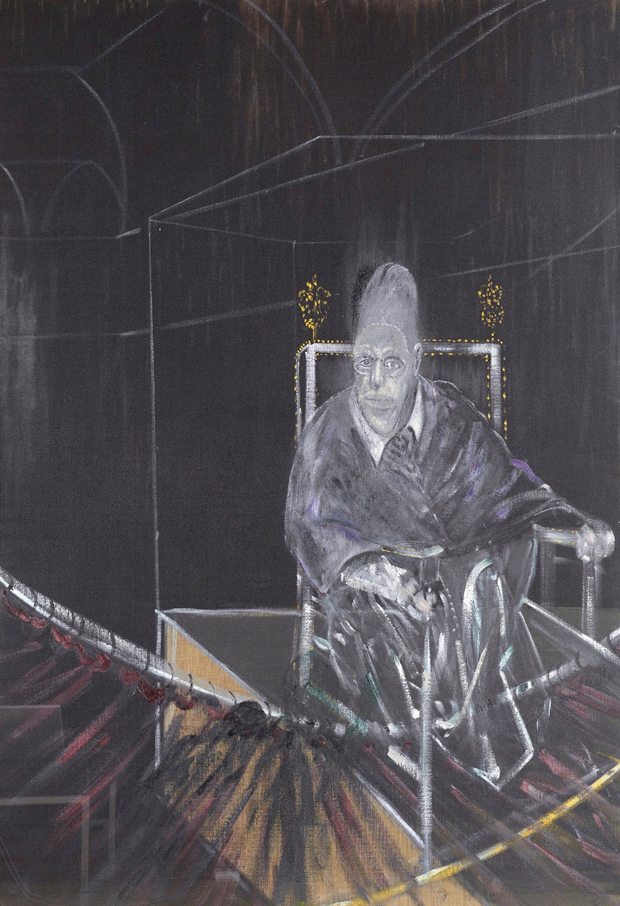
Pope 1 – Study after Pope Innocent X by Velazquez 1951 © The Estate of Francis Bacon. All rights reserved
Bacon’s obsessive reworking of the papal theme suggests that it may have possessed further significance and perhaps psychological charge for the artist in relation to his sexuality. It has been remarked that the Pope in official garb is in a sense the ultimate drag queen, or less literally that depictions of the Holy Father, known in Italy as ‘il Papa’, may encapsulate Bacon’s traumatic feelings about his own father. The latter was a conventional, inflexible military man to whom the teenage Bacon had felt sexually attracted, as he recalled many years later, but who brutally admonished and rejected him when he discovered his son’s homosexual inclinations. Such speculations about the possible ‘subconscious’ content of the pope pictures involve perhaps a rather crude application of the methods of Freudian psychoanalysis. Once again it is neither altogether possible nor helpful to pin Bacon down.
APPROPRIATION OF SPACE
Film locations: Greater London; Hertfordshire; Buckinghamshire
A Clockwork Orange, 1971
Director
Cast
- Malcolm McDowell
- Patrick Magee
- Adrienne Corri
- Miriam Karlin
- Steven Berkoff
- Philip Stone
- David Prowse
visit the film locations
London: Flights: Heathrow Airport; Gatwick Airport
The campus of Brunel University is on Kingston Lane off Hillingdon Hill about a mile south of Uxbridge (tube: Uxbridge), Greater London.
Trivia
With a lick of paint and a few geraniums, Thamesmead South could hardly look more different as the backdrop to 1996’s sweet little gay romance Beautiful Thing.
Not far from the subway location, you can find the spot where Chas (James Fox) phones his gang boss Harry Flowers in another controversial British classic, Performance
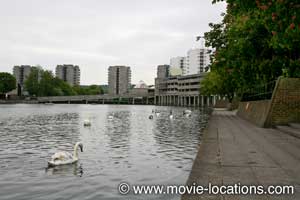
A Clockwork Orange location: ‘Flat Block Marina’: Binsey Walk, Thamesmead South, London SE2
Set vaguely in the north of England, judging by the accents, A Clockwork Orange was made almost entirely on location around London and the Home Counties (the southeastern counties surrounding the capital), with notoriously travel-phobic director Stanley Kubrick choosing locations from architectural guides.
For many years, Kubrick’s refusal to allow the film to be shown in the UK gave his blackly comic version of Anthony Burgess’ novel about free will and control an undeserved reputation as a fearsome video nasty.
Virtually the only purpose-built set, the ‘Korova Milk Bar’, was constructed in a factory just off Borehamwood High Street near to the MGM Studios (where 2001: A Space Odyssey had been shot).

A Clockwork Orange location: ‘Municipal Flat Block 18A, Linear North’: Tavy Bridge Centre, Thamesmead South, London SE2
The grim housing estate of Alex (Malcolm McDowell) is part of the unspeakable concrete disaster that is Thamesmead South, a vast, dismal, windswept collection of tower blocks connected by intimidating walkways. The exterior of his glum home is the Tavy Bridge Centre.
The benighted subway, where the Droogs attack the old tramp, can be found over in West London. It’s a tough call – choosing between the four near-identical subways leading down beneath the traffic island dominated by the huge circular advertising installation on Trinity Road, Wandsworth, deserted, unswept and extremely unnerving. I’m finally convinced that it’s the southern underpass, between Trinity Road and Swandon Way.

A Clockwork Orange location: The attack on the tramp in the sinister subway: Trinity Road, Wandsworth, London SW18
The ‘Flat Block Marina’ is Thamesmead’s artificially created Southmere Lake. Alex reasserts his dominance over fellow Droogs here by dumping Dim in the water and slicing his outstretched hand at Binsey Walk on the Lake’s western shore overlooked by the tower blocks of Yarnton Way.
More futuristic cityscapes (subsequently cut from the film) filmed in the sixties concrete shopping centre of Friar’s Square in Aylesbury, Buckinghamshire. Another urban disaster, the centre was closed down in 1990 and drastically remodelled as a much more friendly redbrick indoor mall.
The derelict casino in which the two gangs clash was on Taggs Island near Hampton Court. It was demolished shortly after filming.
The interior of Alex’s apartment in ‘Municipal Flat Block 18A, Linear North’ is a flat in the village of Elstree – not far from the Borehamwood location. Kubrick, ever the perfectionist, moved out the couple who lived here and spent £5,000 on redecoration. With filming over and the flat restored to its original state, they returned only to be moved out again so two close-ups could be shot.
‘Woodmere Health Farm’, home of Miss Weathers, the cat lady (Miriam Karlin), is Shenley Lodge, Rectory Lane, Shenley, in the Hertfordshire countryside.
Also in Hertfordshire is the interior used for ‘Home’, Patrick Magee’s futuristic pad and site of the notorious ‘Singin’ in the Rain’ rape of Adrienne Corri (when the two met in Hollywood, Gene Kelly allegedly snubbed Kubrick for the use of this number in the scene), why is Skybreak, tucked invisibly away in the tiny village of Warren Radlett, Hertfordshire. The exterior was a modernistic house in Oxfordshire.

A Clockwork Orange location: Alex picks up girls in the record store: McDonalds, Kings Road, London SW3
Fast sex to fast food: the très Sixties chrome and glass Chelsea Drugstore, which stood on the Kings Road at the northwest corner of Royal Avenue, became record shop, where Alex picks up two girls for a spot of high speed ‘in and out’. The shop closed in the Seventies and is now a branch of McDonalds.
The bizarre ‘Duke of New York’ pub was the Old Leather Bottle, 76 Stonegrove, Edgware. It became The Bottle and Dragon, before being closed down in October 2002 and converted into flats.

A Clockwork Orange location: Alex undergoes aversion therapy at the ‘Ludovico Medical Facility’: Brunel University, Uxbridge, Greater London
The ‘Ludovico Medical Facility’, where Alex undergoes the gross aversion therapy, is the campus of Brunel University in Uxbridge, Greater London. The giant overhanging concrete monstrosity is the Lecture Centre in the middle of campus, opposite which Alex is received into the Art Centre. The campus is on Kingston Lane off Hillingdon Hill about a mile south of Uxbridge (tube: Uxbridge).

A Clockwork Orange location: the tramps’ revenge: Albert Bridge, Chelsea Embankment, London SW3
The newly defenceless Alex meets an earlier victim on the Chelsea Embankment at Oakley Street, Chelsea, SW3, and it’s here, under Albert Bridge that the tramps take their revenge
The Shining, 1980
Director
Cast
visit Oregon
Visit: Oregon
Visit: the Timberline Lodge, Mount Hood, just east of Zig Zag on Route 26 (tel: 503.272.3311)
visit Montana
Montana:
Visit: Glacier National Park
visit California
California:
Visit: the Ahwahnee Hotel, in Yosemite Park (tel: (801.559.4884)
visit Colorado
Colorado:
Visit: the Stanley Hotel, 333 Wonderview Avenue, Estes Park (tel: 970.577.4000)
Trivia
Colorado’s Stanley Hotel became the ‘Danbury’, where Jim Carrey and Jeff Daniels occupy the ‘Presidential Suite’ in 1994 comedy Dumb and Dumber.
For more Kubrick locations, see Barry Lyndon, A Clockwork Orange and Eyes Wide Shut.
Second Unit landscape shots from The Shining were used for the ending of Blade Runner on its initial release.

The Shining location: the ‘Overlook Hotel’: Timberline Lodge, Mount Hood, Oregon
Stanley Kubrick’s very free adaptation of the Stephen King novel sees blocked writer Jack Torrance (Jack Nicholson) going barmy in a creepy snowbound hotel.
Although the film was shot almost entirely in the studio at Elstree Studios in Hertfordshire, England, where the hotel interior was constructed, the exterior of the ‘Overlook Hotel’ is the Timberline Lodge, Mount Hood in the Hood River area of Northern Oregon.
Built during the Depression, it’s 45 miles east of Portland, just east of Zig Zag on Route 26. There is no maze at the Timberline – this was built at the old MGM Borehamwood Studios, also in Hertfordshire.
The interior sets were partly based, not on the Timberline, but on the Ahwahnee Hotel, in Yosemite Park, California.
To complicate matters further, it’s sometimes claimed that the film was made at the Stanley Hotel, 333 East Wonderview Avenue, Estes Park in Colorado. This is the hotel in which King stayed in 1973, and which inspired the original story.
The writer detested the Kubrick adaptation, which junked most of his plot in favour of atmosphere, and sanctioned a TV movie remake, which did indeed use the Stanley. The hotel was also seen on-screen in Peter Farrelly’s 1994 Dumb and Dumber.
The opening helicopter shots, of Torrance driving to the Overlook, were filmed by a second unit on Going-to-the-Sun Road, running along the western shore of Saint Mary Lake in Glacier National Park, northeast of Kalispell, Montana. Some of this footage was tacked on to the original release of Ridley Scott’s Blade Runner to provide the ‘happy ending’. Going-To-The-Sun Road appears again (very briefly) during the cross-country run in Forrest Gump.
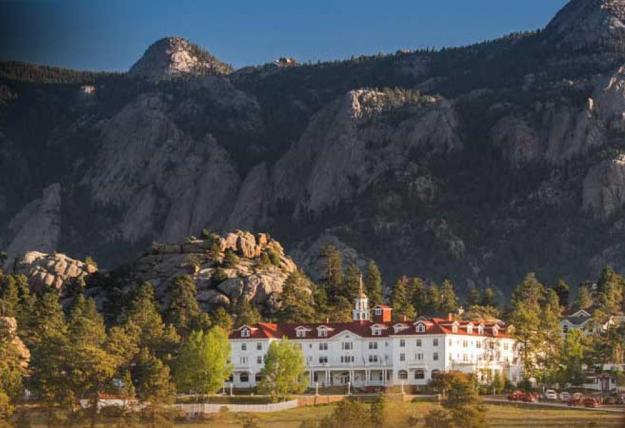
While Stephen King’s visit to The Stanley inspired The Shining, the movie based on the novel wasn’t filmed at the Estes Park hotel.
King and his wife stayed the night in room 217 (room 237 in the film), and The Stanley’s mysterious ambiance is touted as the inspiration for the Overlook Hotel, the ominous setting of his 1977 best-selling novel The Shining. However, Stanley Kubrick’s film based on the book wasn’t filmed at The Stanley, though it has served as the filming location of other productions, including “The Shining” miniseries and “Dumb and Dumber.”
Meanwhile, many guests at The Stanley report feeling the spiritual energy of past guests and employees, including hotel founders F.O. and Flora Stanley. Learn more about Stephen King’s stay and the hotel’s history, architecture and rumored paranormal past on the Stanley Tour and Stanley Night Tour. Or book the Illusions of the Passed Tour for an evening of mystery and storytelling hosted by master magician and “America’s Got Talent” veteran Aiden Sinclair, who uses antiques and artifacts from tragic moments in history to bring the past to life.
in:
Timberline Lodge
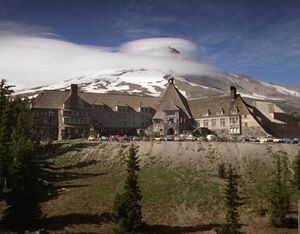
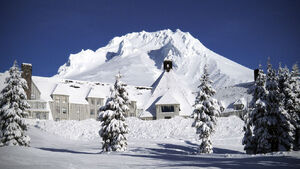
Timberline Lodge in the winter.
Timberline Lodge is a mountain lodge on the south side of Mount Hood in Clackamas County, Oregon, about 60 miles east of Portland, Oregon. Constructed from 1936 to 1938 by the Works Progress Administration, it was built and furnished by local artisans during the Great Depression in the United States. Timberline Lodge was dedicated September 28, 1937, by President Franklin D. Roosevelt. The National Historic Landmark sits at an elevation of 5960 ft, within the Mount Hood National Forest and is accessible through the Mount Hood Scenic Byway. Publicly owned and privately operated, Timberline Lodge is a popular tourist attraction that draws two million visitors annually. It is notable in movie history for serving as the exterior of the Overlook Hotel in The Shining.
